
9 possible freezer troubleshooting fixes & tips
Opening your freezer to find thawing food, odors or frost build-up can disrupt the cooking process and make it harder to let creativity lead the way in the kitchen. Use this guide to learn about 9 possible reasons why a freezer can’t keep up and discover tips on how to troubleshoot a freezer.
What should I do when my freezer stops working?
Before you dive deeper into troubleshooting, do a quick spot check for some simple possible causes of a freezer that stops cooling. First, take a careful look at the refrigerator’s power cord to make sure it’s undamaged and plugged securely into the wall.
Then head to your home’s electrical box and make sure the breaker powering your refrigerator freezer combo is switched to the on position. Once you’ve verified that power sources are in working order, check that your freezer’s thermostat is set to 0ºF (-17ºC).
What to do with food if a freezer stops working?
Preventing food spoilage may be your first course of action when you discover your freezer isn't working. Transfer your food to a chest or upright freezer if possible, or a large cooler filled with ice. Consider briefly storing food outside in the colder winter months or wrap it in several layers of newspaper and cover it with a blanket to keep it cool for several hours.

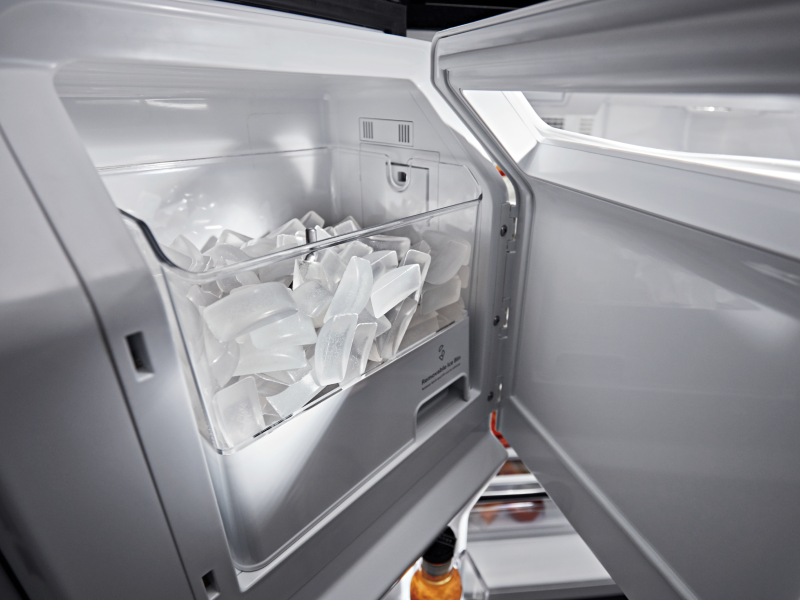
9 possible freezer problems and solutions
With food squared away and the simplest possible causes crossed off your list, you’re ready to continue troubleshooting your freezer. See 9 potential causes for a freezer that won’t work below and possible ways to address them. Every model is different, so be sure to consult your owner’s manual as you troubleshoot through the steps.

1. Freezer is not turning on
The refrigerator’s compressor should kick on and off as it periodically cools each compartment. Listen for 30 minutes to hear if the compressor kicks into gear. If you don’t hear a humming noise during that time frame, it could mean that your freezer’s start relay, start capacitor or defrost timer is faulty and preventing the compressor from functioning properly.
A professional can help diagnose the cause of a dormant compressor and let you know which elements are contributing to the problem.

2. Freezer light is out
Some freezer lights shut off when the door sits open for longer than about 10 minutes and only reset when the door is closed for a short period of time. If you’ve confirmed that the freezer door is shutting completely, but the light still won’t turn on, check that the freezer door switch is activated by making sure the refrigerator is level and the door is aligned properly. Frost can sometimes build up on the door sensor or switch. Check that it is free of frost to ensure it’s working properly. Consult a professional if these quick fixes don’t address the problem.

3. Freezer is leaking water
Freezers can leak water for a handful of reasons, but you can start the troubleshooting process by checking that the ice maker is both producing and dispensing ice. If you notice frost build-up in the ice maker, this could be causing the leak and requires removing and defrosting the ice bin.
The freezer’s evaporator coils—most often located along the back wall—can freeze up and result in a steady leak, or your freezer may have a blockage in the drain line. Contact a professional to inspect your freezer’s evaporator coils for build-up or the drain line for blockage. You can also consult your owner’s manual to learn more about accessing these components.

4. Freezer’s compressor is always running
A compressor that’s always running may mean that cold air is leaking from the freezer compartment through tears in the door’s gasket seal, forcing the compressor to work overtime. Inspect the gasket seal for wear and tear or buildup of soils. Clean the gasket or replace and older or damaged one if necessary with the help of a professional.
More complicated factors—like a defective defrost timer or heater—can lead to frost build-up in the freezer that makes the compressor work harder to maintain cool temperatures. A certified professional can access and inspect these parts to see if they’re in need of replacement, as well as fix any damage you may notice to your freezer’s thermostat or control panel.
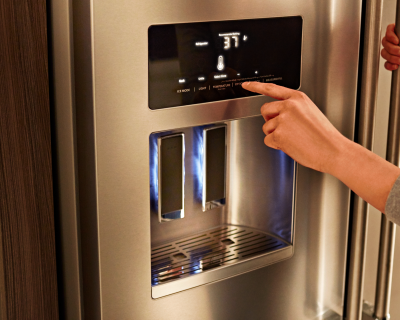
5. Freezer is making strange noises
Most freezer noises are a normal part of operation, but uniquely loud or persistent sounds can indicate a problem. If you notice unusually noisy vibrating, you may need to level your refrigerator-freezer combo. Keeping your refrigerator’s condenser coils clean can help manage loud noises that result from the unit working harder to keep up.
Loud clicking, buzzing or humming may mean your evaporator fan needs replacing. If your freezer is struggling to stay cool and making these loud sounds, consider consulting a professional to inspect and fix any possible damage to your freezer’s evaporator fan.

6. Freezer is too warm
A warm freezer can result from simple causes like a misset thermostat or loose power cord to more complicated issues like damaged components. Rule out some simpler possible causes first by checking the door seal for tears and the condenser coils for dirt and grease build-up (use your owner’s manual to help you locate the coils if necessary). If you notice build-up on the condenser coils, use a vacuum with a crevice attachment to clean them.
Once you’ve checked that the freezer is powered, the thermostat is set properly, the door is well sealed and the condenser coils are clean, consider consulting a professional to inspect your freezer’s other components for damage.
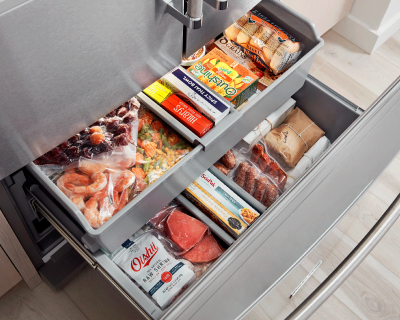
7. Freezer is too cold
Your freezer may be set lower than necessary to keep food frozen, but this shouldn’t impact your food’s quality. It can, however, increase your electricity bill. Aim to keep your freezer at about 0ºF (-17ºC). Though ice crystals on food can seem to indicate a freezer that’s too cold, this is typically a result of freezer burn that sets in when the freezer compartment’s temperature fluctuates too drastically or food is improperly packaged.
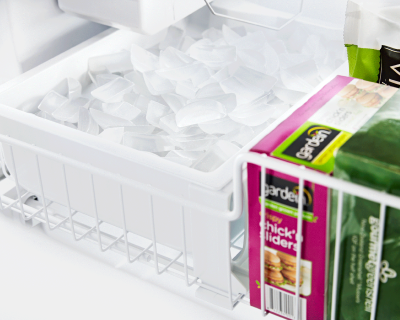
8. Freezer is frosting up
Frost can block the vents and coils in your freezer that help produce and circulate cold air. If your freezer doesn’t have an auto defrost setting, then it’s best to defrost and clean it whenever frost build-up exceeds ¼ inches in thickness, or once a year. Some models, like select KitchenAid® refrigerators, help regulate the temperature of the freezer compartment through the ExtendFresh™ Temperature Management System. This feature maintains optimal temperatures for fresh and frozen food by monitoring and adapting the flow of cold air between the two compartments.
If your freezer seems prone to frosting up despite standard maintenance or an automatic defrost option, consider contacting a professional to help diagnose any potential underlying causes.
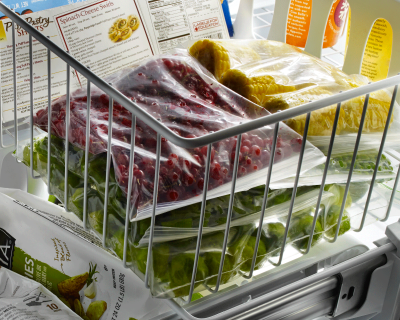
9. Freezer has strange smells
Funky freezer smells can stem from dirty evaporator coils or food that’s improperly wrapped in the freezer compartment. Consult your owner’s manual to learn more about cleaning the evaporator coils, then ensure that old or improperly packaged food is thrown out or repackaged to help reduce odors.
If smells linger, you can try placing a paper bowl of activated charcoal, a box of baking soda or a plate of rolled up newspaper balls with a drop of cooking vanilla into the freezer compartment for several weeks to help absorb odors.
Tips to keep your freezer running smoothly
You can’t always control the causes of a malfunctioning freezer, but there are some steps you can take to help prevent freezer issues. See the tips below to learn how to maintain your freezer and help it operate smoothly.
Help prevent odors by cleaning out your freezer once a month so forgotten items don’t contribute to odors. Clean the nooks and crevices of bins and rails where food spills may hide and label food with dates to help you keep track of what’s still fresh.
Clean condenser coils annually to remove grease, dirt or hair. Not all condenser coils need cleaning, so check your owner’s manual before you begin.
A quick freezer reset may help resolve some issues. If your freezer isn’t performing consistently, try unplugging the freezer, shutting off the breaker switch and turning the temperature controls to zero. Wait several minutes, then reconnect the refrigerator to power and reset the thermostat.
- Overstuffing your freezer can interfere with cold air circulation in the compartment. Be sure to leave room in front of the evaporator fan and between items so air can circulate.
- Opening the door frequently or leaving it open too long can lead to frost build up or fluctuating temperatures, especially in warm and humid weather. Try to minimize how often you access the freezer and don’t linger too long with the door open.
Explore KitchenAid® refrigerators with freezers
KitchenAid® refrigerator freezer combinations offer the capacity, configurations and consistent cooling you need to keep ingredients fresh and ready to use. The Fast Freeze option on select models lowers the freezer temperature with the push of a button to freeze items so they’re ready when you need them. Plus, 4-door, side-by-side, bottom mount, multi-door and French door models mean you can find a refrigerator with a freezer configuration that suits the way you meal prep.

